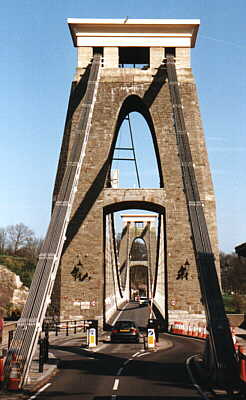
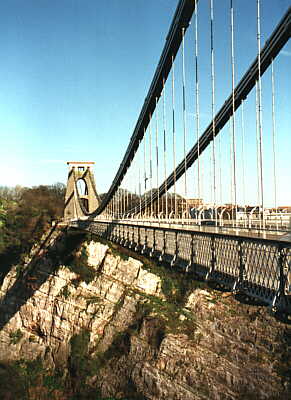
Bristol Suspension Bridge
The first person who flew under the bridge was a Frenchman, M. Tetard in 1911.
In October 2002, Michael Synge emailed me to say that his family legend has it that his uncle, Copper Openshaw, flew under the bridge in a Sopwith Camel biplane around the time of World War I. Michael, with the help Mike Rowland of the Clifton Suspension Bridge Trust later said that in the days of the bi-plane it was common for pilots to "do the Bridge" as a rite of passage, and that the instructor watched from above to make sure they did! There was an RFC training squadron at Filton airfield during WW1 and it is believed many of the pilots stayed at the Avon Gorge Hotel (where no doubt there was a good claret available!) The practice of flying under the Bridge was not officially condoned but nevertheless occurred occasionally right up until the 1930's and beyond.
In 1957, Flying Officer Crossley, who was based in Filton, tried to fly under the bridge in a de Havilland Vampire jet. After going under the bridge it all went wrong for him and he crashed into the Leigh Woods side of the gorge, killing himself instantly. His was the last flight by anyone under the bridge.
In December 2002, I emailed Mr Vic Flintham for permission to use one of the Vampire jet photographs on his website (Internet Archive). He very graciously allowed me to use them. Not only that, but he provided the following information about Flying Officer Crossby and his stunt.
Here's what Vic wrote to me :-
The aircraft might have been from 501 Squadron given that you mentioned Filton which never had operational units (501 was a reserve squadron). The Royal Auxiliary Air Force disbanded in 1957, so putting two and two together I assumed an unauthorised flight by a pilot shortly due to leave the RAF (he would only have been a week-end flyer). In the event it looks a touch sadder. Here are the details.
The aircraft was a Vampire FB Mk 9 WR260 of 501 Sqn at Filton and the date was 3rd February 1957. The pilot was Flying Officer John Greenwood Crossley RAuxAF aged 27 years. The reference that I have on the accident (from 'To Fly No More' by Colin Cummings) reads as follows: "The Royal Auxiliary Air Force was about to disband. This pilot took off without authority and did not wear a helmet nor did he secure his harness and parachute and he left the pitot cover in place. After about 20 minutes, he flew under the Clifton Suspension Bridge in the Avon Gorge near Bristol. Having passed beneath the bridge he pulled up into a slow roll and entered cloud. He emerged from cloud inverted and rolled out slowly losing height. He then turned to port, levelled the wings and began to lose height more rapidly before striking the side of the gorge." (In case you don't know the pitot is an open-ended tube, usually on the wing, which by allowing air in gives you your airspeed. You cannot fly properly without knowing your airspeed and you certainly can only land with great risk.) Incidentally the speed you suggest is too high [originally 450 mph] and would probably have been nearer 250 knots. My guess would be suicide.
My thanks to Mr Flintham for the above information. Not only did he provide that information, but also identified the planes whose pictures appear in the HMS Warrior Planes section of "Dads Navy Days". Vic writes the wonderful website, Post-war Military Aviation (Internet Archive).
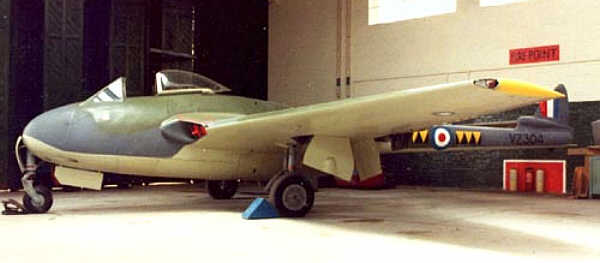
This Vampire Mk 5 has the markings of 501 Sqdn RAuxAF
The photos above and below are used with kind permission of Mr Vic Flintham
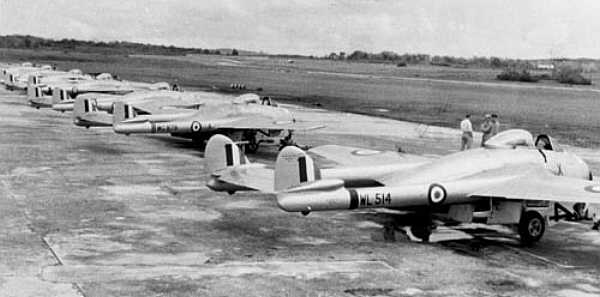
These are Vampire Mk 9 aircraft, similar to the one flown by Flying Officer John Greenwood Crossley
When I was looking around for pictures of Vampire jets, I also came across the following one...
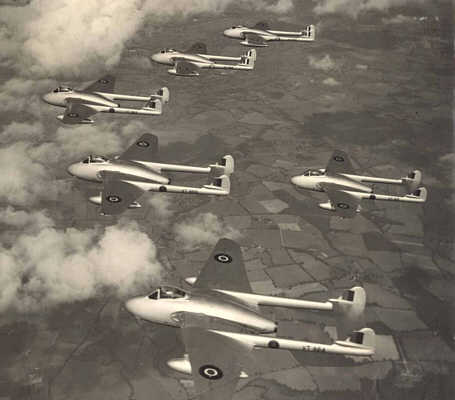
These six Vampire Mk 3 aircraft made the first Atlantic crossing by jet ~ 12th - 14th July 1948.
Photo used by kind permission of William Wood and Katie Jones from Only Birds and Fools Fly
Bill should know about this trip, he's flying VT864, the one nearest the camera.
More information on John Crossley arrived in an email from Tom Routledge in March 2004. Tom is a Canadian, but in 1957, he was in Bristol as a "student-apprentice" at Bristol Aero-Engines - doing practical engineering things with gas-turbine engines, prior to returning to McGill University in Montreal for his degree. Tom writes ...
John was a fine young man - a bit taken with the "silk-scarf" romanticism of the R.A.F., post-WW-2. He and a few of us used to have a pint together in the Plough Inn in Patchway after work...One of your writers mentioned that he thought it might have been suicide. It certainly was NOT. He was just trying to fulfill a young man's dream, and he knew that his chance would be gone shortly - as they were going to disband the squadron where he did his weekend reserve RAF flying - in DH Vampires. He was selected to be one of three pilots to do a ceremonial flypast at Filton - at the "de-mobbing" ceremony of the squadron that had distinguished itself a little over a decade before. In a training flight, he took off early - and headed for the bridge. After flying under it he was so elated that he did a roll as he flew along the Avon Gorge - and lost control. A tragic end to a young man's life - and yes, largely because of youthful stupidity. I remember at the time that some of his weekend-pilot friends used to raise a drink to "good old John - who died as he would have liked" ... and I thought then, as I do now, BULLSHIT - it was a terrible waste.
I was looking through some old newspapers for research into something else at the Bristol Reference Library and found the following article from the Bristol Mercury dated Saturday 14th August 1841 (exactly the same story appeared in the Bristol Gazette, dated Thursday 12th August 1841) :-
An accident, which might have been attended with fatal effects, took place on Saturday last. Two gentlemen who had arrived by the railway on a party of pleasure, were induced to pass over the river in the basket attached to the iron rod, which passes from side to side. This rod of course bends in the centre, and a rope is afixed to the basket to draw it up as it approaches the land. On the above occasion, the party had arrived within a few feet of the landing, when the rope suddenly broke and the basket was rapidly impelled back to the centre of the rod. Considerable alarm was felt by the spectators on the shore, by the passengers in a steam-packet passing beneath at the time, and more particularly by the affrighted tenants of the basket themselves, who however, were ultimately relieved without any personal injury. This dangerous practice of passing over will soon be put a stop to, as the contractors have at last succeeded to the satisfaction of Mr Brunel, in welding iron for the chains of a proper consistancy, and there is now every prospect of the work progressing as soon as the weather shall prove favourable.
Crossing the Bridge there are magnificent views both across the City and down the Gorge.
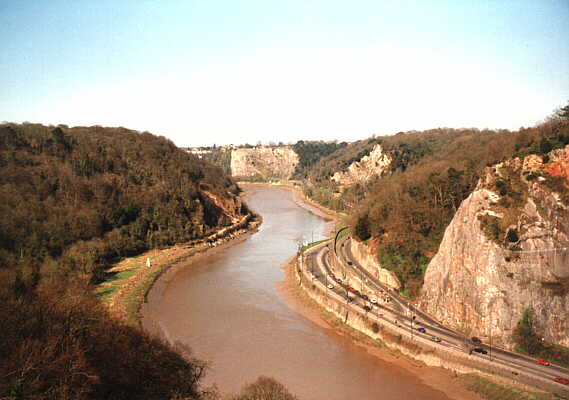
The Avon Gorge from the Suspension Bridge
The road is the Portway, this runs the length of the gorge and when it was opened in 1931 was the most expensive road per mile in Britain. To the left of the river can be traced the old Bristol to Portishead railway, closed in the 1960's, and, partially obscured by a shadow, the tunnel it used to run through. The gorge is home of several species of plants that are found nowhere else. The Flower of Bristol, lychnis chalcedonica, grows here as does the Bristol Onion and the Bristol Whitebeam which can grow up to thirty feet tall.
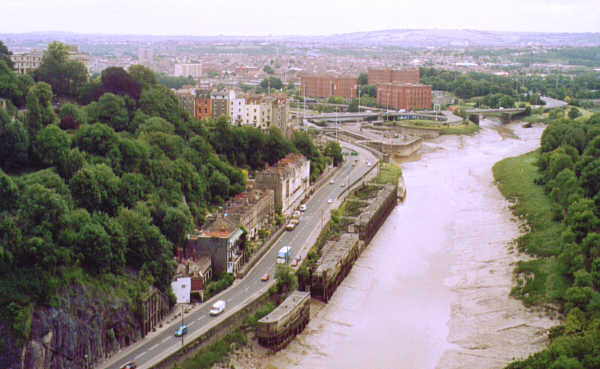
Bristol from the Clifton Suspension Bridge
This page created March 18, 2000; last modified November 13, 2022






